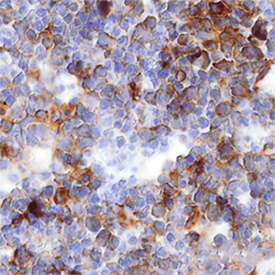Mouse IGFBP-1 Antibody Summary
Ala26-Asn272
Accession # P47876
Applications
Please Note: Optimal dilutions should be determined by each laboratory for each application. General Protocols are available in the Technical Information section on our website.
Scientific Data
 View Larger
View Larger
IGFBP‑1 in Mouse Embryo. IGFBP-1 was detected in immersion fixed frozen sections of mouse embryo (13 d.p.c.) using Goat Anti-Mouse IGFBP-1 Antigen Affinity-purified Polyclonal Antibody (Catalog # AF1240) at 15 µg/mL overnight at 4 °C. Tissue was stained using the Anti-Goat HRP-DAB Cell & Tissue Staining Kit (brown; Catalog # CTS008) and counterstained with hematoxylin (blue). Specific staining was localized to developing liver. View our protocol for Chromogenic IHC Staining of Frozen Tissue Sections.
Reconstitution Calculator
Preparation and Storage
- 12 months from date of receipt, -20 to -70 °C as supplied.
- 1 month, 2 to 8 °C under sterile conditions after reconstitution.
- 6 months, -20 to -70 °C under sterile conditions after reconstitution.
Background: IGFBP-1
The insulin-like growth factor binding protein (IGFBP) family consists of six structurally related proteins that bind IGF with high affinity (1, 2). These proteins share conserved cysteine-rich N- and C- terminal regions that participate in IGF binding. IGFBPs regulate the bioavailability of IGFs and modulate their biological activities, both positively and negatively. Some IGFBPs also have intrinsic bioactivity that is IGF-independent. Post-transitional modifications of the IGFBPs, including glycosylation, phosphorylation and proteolysis, influence IGF binding affinities and tissue localization, affecting both the IGF-dependent and independent functions (1, 2).
Mouse IGFBP-1 cDNA encodes a 272 amino acid (aa) residue precursor protein with a putative 25 aa signal peptide (3). Mature mouse IGFBP-1 contains potential phosphorylation and proteolytic cleavage sites, an Arg-Gly-Asp (RGD) integrin receptor recognition sequence, but lacks potential N-linked glycosylation sites. IGFBP‑1 binds equally well to IGF-I and IGF-II. Phosphorylation of human IGFBP-1, but not rat IGFBP-1, increases IGF affinity. Mouse IGFBP-1 shares 67% and 93% aa sequence identity with human and rat IGFBP-1, respectively. IGFBP-1 is expressed in liver, decidua, and kidneys and is the most abundant IGFBP in amniotic fluid. Hepatic production of IGFBP-1 is down-regulated by insulin and up-regulated by glucocorticoids. Circulating IGFBP-1 levels are elevated under various catabolic conditions including bacterial or viral infections, trauma and diabetes (4). IGFBP-1 has been shown to either potentiate or inhibit the activities of IGF in a variety of cells. IGFBP-1, through its RDG motif, also interacts with alpha 5 beta 1 intergrin to stimulate changes in cell adhesion and migration in the absence of IGFs (1, 2).
- Firth, S.M. and R.C. Baxter (2002) Endocrine Reviews 23:824.
- Rajaram, S. et al. (1997) Endocrine Reviews 18:801.
- Schuller, A.G. et al. (1994) Mol. Cell. Endocrinol. 104:57.
- Lang, C.H. et al. (2003) Endocrinology 144:3922.
Product Datasheets
FAQs
No product specific FAQs exist for this product, however you may
View all Antibody FAQsReviews for Mouse IGFBP-1 Antibody
Average Rating: 5 (Based on 1 Review)
Have you used Mouse IGFBP-1 Antibody?
Submit a review and receive an Amazon gift card.
$25/€18/£15/$25CAN/¥75 Yuan/¥2500 Yen for a review with an image
$10/€7/£6/$10 CAD/¥70 Yuan/¥1110 Yen for a review without an image
Filter by:


